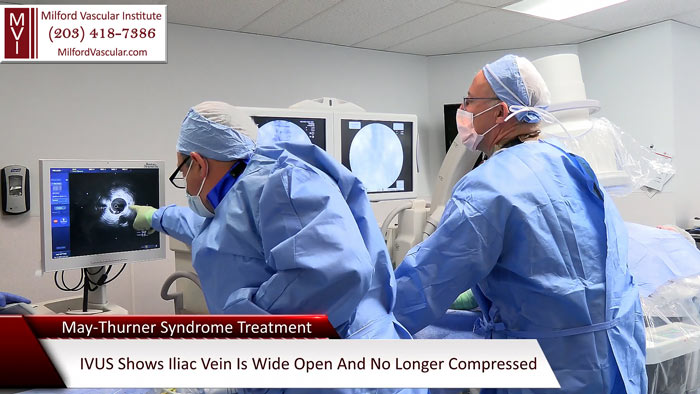May-Thurner Syndrome
(Iliac Vein Compression) Causes Swelling Of The Left Leg

May-Thurner Syndrome, occurs when the iliac vein is compressed by the iliac artery against the spine. It is also called iliac vein compression.
Iliac vein compression causes restricted blood flow from the legs up to the heart, resulting in leg pain, leg swelling and chronic venous insufficiency. Left untreated, it can put you at risk of leg ulcers and potentially deadly blood clots.
At Milford Vascular Institute our expert vascular surgeons use the IVUS procedure (intravascular ultrasound) to diagnose and treat May-Thurner Syndrome on an outpatient basis in our office-based laboratory.
The procedure is performed through a small needle hole under light sedation, takes less than an hour to perform and allows for no downtime and quick recovery time.
LEFT UNDIAGNOSED AND
UNTREATED MAY-THURNER SYNDROME CAN LEAD TO DANGEROUS LEG ULCERS
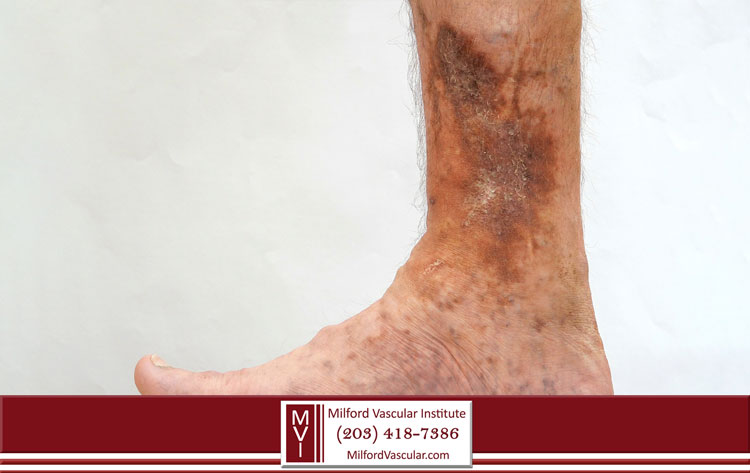
So, if you are experiencing leg pain or leg swelling, especially in the left leg, it is recommended to have a vascular consultation as soon as possible to help determine if your symptoms may be due to May-Thurner Syndrome.
Many people have suffered from May-Thurner Syndrome and gone undiagnosed for years, severely affecting their quality of life.
Board Certified Vascular Surgeon Dr. Esposito Explains May-Thurner Syndrome
“In May-Thurner Syndrome, an artery can push down on the vein and cause basically an obstruction of that vein. As the veins are trying to bring blood out of the leg to the heart, that becomes very difficult.
So what happens is the blood stays in the leg longer than it should, and can lead to leg swelling and all the conditions that go along with leg swelling.
In the video below, you can watch how we diagnosed and treated a patient with May-Thurner Syndrome right here in our office-based laboratory using IVUS intravascular ultrasound. With IVUS we are looking at ultrasound images from inside the vein itself, allowing us to be extremely precise in our diagnosis and treatment.”
~ Dr. David Esposito
Board Certified Vascular Surgeon
“By placing a stent inside the compressed iliac vein, then pushing it into the vein wall by deploying a balloon, we were able to fully open up the iliac vein to restore healthy blood flow.
The entire procedure is performed through a tiny needle hole in the groin, under sedation, where the patient feels no pain.
The patient will have no downtime, and will begin to feel relief from her symptoms within 6-8 weeks.”
~ Dr. David Esposito
Board Certified Vascular Surgeon
What Is May-Thurner Syndrome (Iliac Vein Compression)?
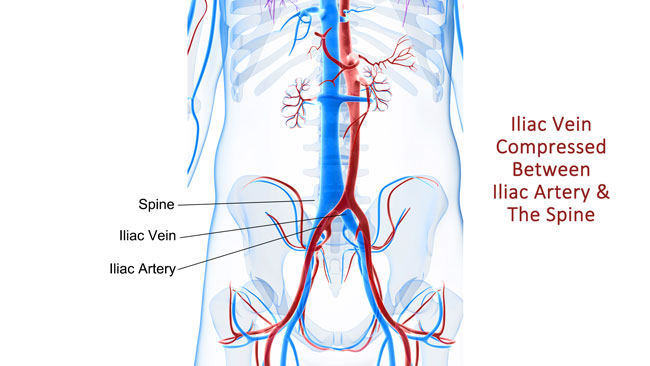
Iliac vein compression, also known as May-Thurner Syndrome is a condition in which the iliac vein becomes compressed between the iliac artery and the spine.
The iliac vein is very important in that it carries blood up from the legs towards the heart.
When the iliac vein becomes compressed, it restricts blood flow from the legs to the heart, causing blood to accumulate in the leg.
The result is stagnant blood pooling in the leg, causing leg swelling, leg pain and an increased risk of developing leg ulcers and potentially deadly blood clots.
May-Thurner Syndrome Causes
May-Thurner Syndrome is not a hereditary vascular disease, but is recognized as an anatomical variant that affects 20%-30% of people at some point in their lives.
It occurs more commonly in females. The risk of developing May-Thurner Syndrome increases with the use of oral contraceptives, in those with scoliosis, those who suffer from dehydration, and hypercoagulable disorders.
May-Thurner Syndrome Symptoms
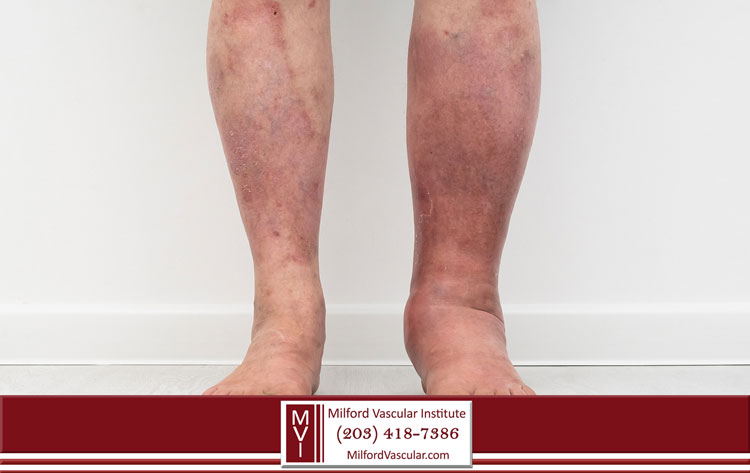
Although some people with May-Thurner Syndrome may experience mild symptoms, or no symptoms at all, as the condition progresses, you can start to experience the following symptoms:
If you have been experiencing any of these symptoms, at Milford Vascular Institute, we can quickly and easily evaluate your condition and determine if you have May-Thurner Syndrome.
Early diagnosis and treatment are highly recommended to prevent potential vein damage in the lower legs that can lead to leg ulcers that do not heal and the development of blood clots.
May-Thurner Syndrome Diagnosis
IVUS INTRAVASCULAR ULTRASOUND
IMAGE SHOWS EXACT ILIAC VEIN COMPRESSION LOCATION & PERCENT STENOSIS
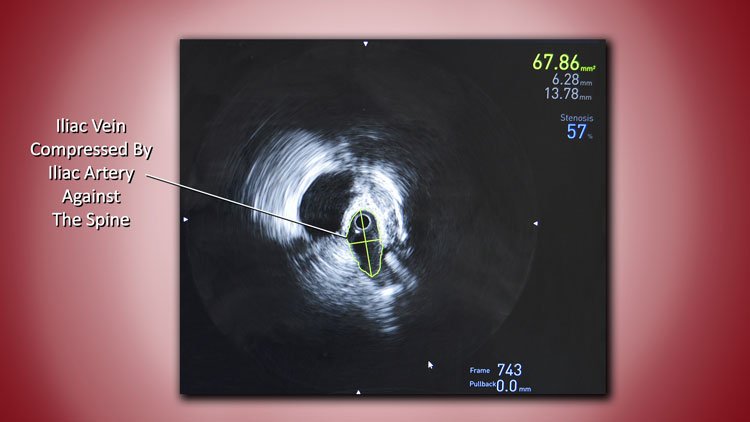
Although the iliac vein can be imaged using doppler ultrasound, CT scan and venography, these imaging techniques may not always be effective in diagnosing May-Thurner Syndrome.
The reason is that vein compression is not always evident when using 2-dimensional imaging.
With the development of IVUS intravascular ultrasound, vascular specialists and radiologists can now put an ultrasound probe right into the iliac vein to get a 360-degree view from inside the vein.
This helps identify the exact location and extent of compression. IVUS also helps us measure the percentage of stenosis of the iliac vein for the most precise diagnosis of iliac vein compression available anywhere.
Using The Most Advanced
Technology Available Anywhere To Treat May-Thurner Syndrome
Here at Milford Vascular Institute, our top-rated vascular specialists serving New Haven, Bridgeport, Stamford and all of Southern Connecticut, use the most advanced minimally-invasive techniques available anywhere in the world to treat May-Thurner Syndrome.
MAY-THURNER SYNDROME TREATMENT USING IVUS INTRAVASCULAR ULTRASOUND
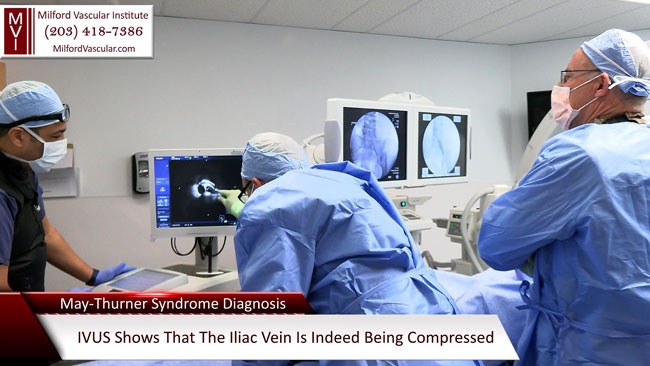
At Milford Vascular Institute’s office-based laboratory, our vascular surgeons treat May-Thurner Syndrome using balloon angioplasty and stenting to open up the compressed iliac vein.
The entire procedure is performed through a small needle hole in the groin, while the patient is under light sedation.
Using IVUS guidance, a stent is precisely placed at the points of iliac vein compression to widen the iliac vein enough to restore healthy blood flow.
IVUS IMAGING OF THE ILIAC VEIN BEFORE AND AFTER TREATMENT
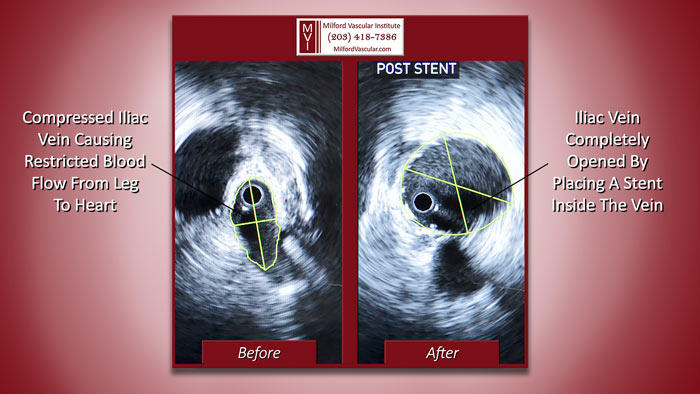
After the stent has been placed and circulation has been restored, the symptoms of leg swelling and leg pain should resolve within 6-8 weeks.
Following the procedure, patients can resume their normal activities, and the needle hole will heal without the need for stitches.
Why Choose

When you choose Milford Vascular Institute for treatment of May-Thurner Syndrome, you can rest assured that you are getting the very best possible vascular care available in all of New Haven County. Our vascular specialists are highly skilled in providing the most advanced, minimally-invasive vascular treatments available anywhere.
At MVI, board certified vascular surgeon Dr. David Esposito and board certified interventional radiologist Dr. Paul Davis, who is board certified in diagnostic radiology, and vascular and interventional radiology, will perform your May-Thurner Syndrome surgery in our office-based laboratory.
Dr. Esposito and Dr. Davis are top-rated experts in endovascular treatments. They are always at the forefront of technology in the vascular surgery field to ensure they are providing the best, cutting-edge vascular treatments to their community.

With over 50 years of combined experience in diagnosing, preventing and treating vascular diseases, our outstanding vascular specialists have dedicated their lives to caring for you.
With over 20 years in practice, at Milford Vascular Institute, our staff is committed to excellent patient care, always treating our patients with respect and compassion because WE CARE.

Our MVI Team ~ Always Treating You Like Family
If you’ve started to experience leg swelling, leg pain or any of the symptoms associated with iliac vein compression (May-Thurner Syndrome), it is important to have an evaluation with a vascular specialist as soon as possible.
Through a simple in-office consultation, and ultrasounds to rule out other vascular disorders, we can determine if your symptoms may be due to May-Thurner Syndrome. If we suspect that they are, we can easily diagnose and treat May-Thurner Syndrome right in our office-based laboratory.
Treatment takes less than an hour to perform, is minimally-invasive, and performed on an outpatient basis under light sedation.
You will be able to go home and resume normal activities, with no downtime and quick recovery.
To schedule a consultation with one of our top-rated vascular specialists here at Milford Vascular Institute, give us a call today at (203) 418-7386. It will be our pleasure to care for you.

